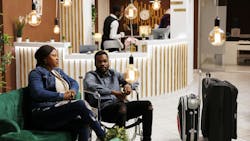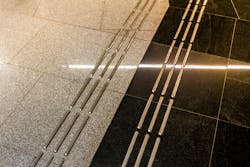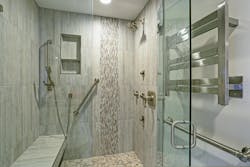Adaptive Furnishings and Fixtures Deliver Fully Inclusive Hotels
There is a growing awareness that many services and features in today’s society create barriers for individuals with disabilities. As society moves toward greater inclusivity, hotels can take a proactive approach to ensure their accommodations are accessible to all guests.
Business and Social Imperatives for Inclusivity
The World Health Organization estimates that 1.3 billion people worldwide live with disabilities. Catering to a wider spectrum of guests goes beyond inclusivity. It’s also a smart business strategy that expands a hotel’s market reach.
Moreover, investing in accessible design helps future-proof a business. It benefits individuals with disabilities and extends service to older adults, families with young children, and people recovering from injuries.
Prioritizing inclusive design delivers tangible financial benefits. Accessible tourism is a thriving industry, and American adults with disabilities opt for accessible accommodations when traveling.
Adaptive Design in Common Areas
Renovating hotels to accommodate client needs requires thorough planning, especially for older, long-established hotels, as they may have limitations that impact their integrity when fitted with modern amenities. The following areas represent the best places to integrate adaptive features to transform guest experiences.
Entryways and parking lots are the first access a guest encounters on the hotel property. If a customer can’t enter the hotel, business stops there. Barrier-free access begins long before guests even step inside. For instance, accessible parking spaces parking spaces should have clear markings, curb ramps, and adequate space for vehicle lifts.
Next, design step-free pathways with smooth, slip-resistant surfaces. Hardened materials—such as asphalt, concrete and tile—provide firm and stable surfaces. Loose gravel, on the other hand, must be avoided.
At the building entrances, consider automated sliding doors or push-button entry systems. These door styles let guests know that the hotel prioritizes accessible accommodations, whereas revolving door systems can present a challenge to those with mobility concerns. And incorporate tactile and high-contrast wayfinding signage to assist guests with visual impairments.
Once guests enter the hotel, their impression of the accommodations begins with the lobby and reception area. Every service must be both welcoming and functional. This includes installing a lowered reception counter measuring 28 to 34 inches to accommodate wheelchair users.
Check-in desks or kiosks should also be equipped with hearing loop systems to assist guests who are hard of hearing. A hearing loop transmits sound directly to hearing aids or cochlear implants, reducing background noise and ensuring clear, amplified communication. For guests with low vision, digital check-in kiosks are only beneficial if they include voice assistance and screen readers. These features convert on-screen text into spoken words, enabling guests to navigate the kiosk independently without relying on sight.
Furthermore, the lobby seating area should offer flexible seating arrangements—such as chairs with and without armrests—to accommodate guests with varied mobility needs.
Elevating Guest Rooms for All
Now that guests have navigated the welcome areas, consider the halls and guest rooms for improved, adaptable accommodations. Room number signs should include Braille. Another option is tactile paving or flooring that helps guests with low vision or blindness navigate hotel corridors and common areas.
While many hotel rooms meet ADA compliance, true inclusivity goes beyond regulations by offering thoughtful, proactive solutions that ensure accessibility without requiring guests to ask. Voice-activated or mobile-app room controls can further enhance accessibility when it comes to seamless lighting and climate control. Additionally, fumbling for a phone may not be an option in an emergency. Installing marked emergency pull cords beside the bed and in bathrooms allows guests to easily call for immediate assistance.
Although the ADA does not specify bed height regulations, the ideal height for most wheelchair users is between 20 and 23 inches from the ground, with sufficient under-bed clearance to accommodate a lift or wheelchair footrests. Providing closet rods and shelves at varying heights ensures guests with different reach abilities can access storage comfortably.
Bathrooms should be thoughtfully designed to enable guests to navigate comfortably, independently, and safely while adding a level of sophisticated style.
Indeed, safety is paramount in hotel bathrooms. Slip-resistant flooring reduces the risk of accidents, benefiting not just individuals with disabilities but also older adults, families with young children, and all guests who appreciate a secure, stable surface.
Motion-activated lighting, faucets, and soap dispensers benefit guests with dexterity impairments. Floating vanities offer a sleek, modern look while serving a greater purpose: providing wheelchair users with unobstructed access to the sink and countertop.
Roll-in showers large enough for wheelchair users to easily maneuver offer a contemporary look while eliminating steps. Grab bars, a detachable showerhead, and built-in shower seat are also great additions for comfort and functionality.
Inclusive Hotels Welcome Everyone
Hospitality’s golden rule is to treat guests how you would like to be treated—with empathy and respect. It’s about anticipating needs and going further to ensure memorable guest experiences. For individuals with disabilities, this principle is even more essential. A truly inclusive hotel adopts an adaptive design beyond mere compliance to afford all guests comfort, dignity, and independence.
About the Author

Evelyn Long
Freelance writer
Evelyn Long is an experienced interior design writer that has been featured on the National Association of Realtors and DecorMatters sites. She specializes in improving workplaces for a diverse and modern workforce. She is also the editor-in-chief of Renovated Magazine, where she writes interior design advice for homeowners.



